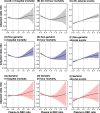Association between the plasma-to-red blood cell ratio and survival in geriatric and non-geriatric trauma patients undergoing massive transfusion: a retrospective cohort study
- PMID: 35016735
- PMCID: PMC8753889
- DOI: 10.1186/s40560-022-00595-7
Association between the plasma-to-red blood cell ratio and survival in geriatric and non-geriatric trauma patients undergoing massive transfusion: a retrospective cohort study
Abstract
Background: The benefits of a high plasma-to-red blood cell (RBC) ratio on the survival of injured patients who receive massive transfusions remain unclear, especially in older patients. We aimed to investigate the interaction of age with the plasma-to-RBC ratio and clinical outcomes of trauma patients.
Methods: In this retrospective study conducted from 2013 to 2016, trauma patients who received massive transfusions were included. Using a generalized additive model (GAM),we assessed how the plasma-to-RBC ratio and age affected the in-hospital mortality rates. The association of the plasma-to-RBC ratio [low (< 0.5), medium (0.5-1.0), and high (≥ 1.0)] with in-hospital mortality and the incidence of adverse events were assessed for the overall cohort and for patients stratified into non-geriatric (16-64 years) and geriatric (≥ 65 years) groups using logistic regression analyses.
Results: In total, 13,894 patients were included. The GAM plot of the plasma-to-RBC ratio for in-hospital mortality demonstrated a downward convex unimodal curve for the entire cohort. The low-transfusion ratio group was associated with increased odds of in-hospital mortality in the non-geriatric cohort [odds ratio 1.38, 95% confidence interval (CI) 1.22-1.56]; no association was observed in the geriatric group (odds ratio 0.84, 95% CI 0.62-1.12). An increase in the transfusion ratio was associated with a higher incidence of adverse events in the non-geriatric and geriatric groups.
Conclusion: The association of the non-geriatric age category and plasma-to-RBC ratio for in-hospital mortality was clearly demonstrated. However, the relationship between the plasma-to-RBC ratio with mortality among geriatric patients remains inconclusive.
Keywords: Damage control resuscitation; Geriatric trauma; Massive transfusion; Trauma registry.
© 2022. The Author(s).
Conflict of interest statement
The authors declare that there are no competing financial interests
Figures



Similar articles
-
Outcomes of patients receiving a massive transfusion for major trauma.Br J Surg. 2018 Oct;105(11):1426-1434. doi: 10.1002/bjs.10905. Epub 2018 Jul 12. Br J Surg. 2018. PMID: 29999518
-
Association Between Ratio of Fresh Frozen Plasma to Red Blood Cells During Massive Transfusion and Survival Among Patients Without Traumatic Injury.JAMA Surg. 2017 Jun 1;152(6):574-580. doi: 10.1001/jamasurg.2017.0098. JAMA Surg. 2017. PMID: 28273299 Free PMC article.
-
Older Blood Is Associated With Increased Mortality and Adverse Events in Massively Transfused Trauma Patients: Secondary Analysis of the PROPPR Trial.Ann Emerg Med. 2019 Jun;73(6):650-661. doi: 10.1016/j.annemergmed.2018.09.033. Epub 2018 Nov 15. Ann Emerg Med. 2019. PMID: 30447946 Free PMC article. Clinical Trial.
-
Meta-analysis of plasma to red blood cell ratios and mortality in massive blood transfusions for trauma.Injury. 2013 Dec;44(12):1693-9. doi: 10.1016/j.injury.2012.07.193. Epub 2012 Sep 25. Injury. 2013. PMID: 23021369 Review.
-
[1/1 plasma to red blood cell ratio: an evidence-based practice?].Ann Fr Anesth Reanim. 2011 May;30(5):421-8. doi: 10.1016/j.annfar.2011.02.015. Epub 2011 Apr 29. Ann Fr Anesth Reanim. 2011. PMID: 21531112 Review. French.
Cited by
-
Analysis of Massive Transfusion Protocol Utilization in Trauma Across Sociodemographic Groups.Medicina (Kaunas). 2025 Jun 24;61(7):1133. doi: 10.3390/medicina61071133. Medicina (Kaunas). 2025. PMID: 40731763 Free PMC article.
-
High Fresh Frozen Plasma to Red Blood Cell Ratio and Survival Outcomes in Blunt Trauma.JAMA Surg. 2024 Nov 1;159(11):1272-1280. doi: 10.1001/jamasurg.2024.3097. JAMA Surg. 2024. PMID: 39167374
-
Extracorporeal cardiopulmonary resuscitation in hypothermic cardiac arrest: A secondary analysis of multicenter extracorporeal cardiopulmonary resuscitation registry data in Japan.Resusc Plus. 2024 Jul 2;19:100705. doi: 10.1016/j.resplu.2024.100705. eCollection 2024 Sep. Resusc Plus. 2024. PMID: 39049960 Free PMC article.
References
-
- Cannon JW, Khan MA, Raja AS, Cohen MJ, Como JJ, Cotton BA, et al. Damage control resuscitation in patients with severe traumatic hemorrhage: a practice management guideline from the Eastern Association for the Surgery of Trauma. J Trauma Acute Care Surg. 2017;82:605–617. doi: 10.1097/ta.0000000000001333. - DOI - PubMed
-
- Gonzalez E, Moore EE, Moore HB, Chapman MP, Chin TL, Ghasabyan A, et al. Goal-directed hemostatic resuscitation of trauma-induced coagulopathy: a pragmatic randomized clinical trial comparing a viscoelastic assay to conventional coagulation assays. Ann Surg. 2016;263:1051–1059. doi: 10.1097/sla.0000000000001608. - DOI - PMC - PubMed
-
- Stewart RM, Park PK, Hunt JP, McIntyre RC, Jr., McCarthy J, Zarzabal LA, et al. Less is more: improved outcomes in surgical patients with conservative fluid administration and central venous catheter monitoring. J Am Coll Surg. 2009;208:725–35; discussion 35–7. 10.1016/j.jamcollsurg.2009.01.026. - PubMed
LinkOut - more resources
Full Text Sources

